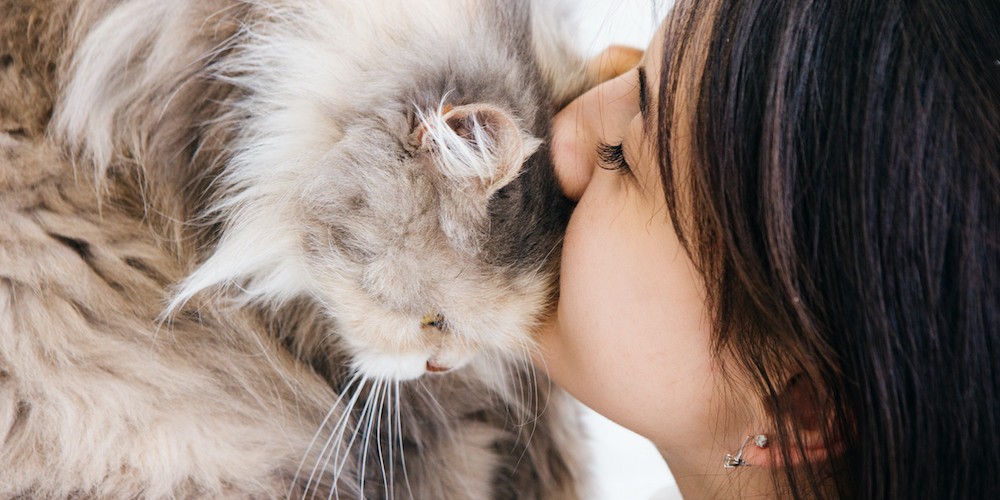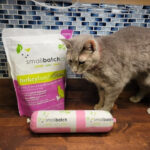If you share your life with a feline companion, you’ve likely been on the receiving end of a cat headbutt, often referred to as cat bunting. This endearing behavior is more than just a cute quirk; it’s a key way cats communicate and interact with their world. But what exactly does it mean when your cat headbutts you or your furniture? The primary reason behind this action is scent marking through pheromones. This behavior plays a vital role in self-soothing, creating bonds, and establishing a sense of security. Let’s delve deeper into the fascinating world of cat headbutting and uncover the meaning behind this common feline gesture.
What is Cat Headbutting?
Cat headbutting, or cat bunting, is characterized by a cat gently bumping their head against a person or object, often followed by rubbing their cheek against the same surface. This action can be directed towards you, other pets, pieces of furniture, or even inanimate objects. This distinctive behavior is a clear sign of cat bunting in action. It’s a common way for cats to interact with their environment and the beings within it.
 Cat headbutting a dog
Cat headbutting a dog
The Science Behind Cat Bunting: Pheromones and Colony Scent
Why do cats engage in headbutting? The driving force behind cat bunting is the creation of a “colony scent.” Cats possess scent glands in various locations on their bodies, including their cheeks, lips, forehead, flanks, paw pads, and tail. When a cat headbutts, they are utilizing these scent glands to deposit pheromones onto you or an object. These pheromones are odorless to humans but serve as crucial communication signals for cats and other felines. By leaving their scent, cats achieve several important objectives:
- Marking their Owners to Create a Colony Scent: Headbutting you is a way of marking you as a member of their family group. This scent exchange helps to establish a shared “colony scent,” reinforcing social bonds within the household.
- Bonding with Other Cats: Cats living together often headbutt each other as a way to mingle scents and strengthen their social connection. This mutual grooming and scent sharing is a sign of feline camaraderie.
- Mapping their “Safe Zones”: Cats use headbutting to mark areas and objects that they consider safe and secure. By depositing their pheromones, they create a familiar and comforting scent environment.
- Self-Soothing: The act of releasing pheromones can also have a self-soothing effect on cats. The familiar scent they leave behind can contribute to their sense of well-being and reduce anxiety.
 Cat headbutt
Cat headbutt
Is Cat Bunting a Sign of Affection?
While cat bunting is primarily about scent marking and establishing a safe environment, it does carry an element of affection. Cats are unlikely to headbutt individuals they don’t trust or feel comfortable around. Therefore, while it’s not solely an expression of love in the human sense, cat headbutting indicates that your cat feels secure and at ease in your presence. In this way, it can certainly be interpreted as a positive sign and a form of feline affection.
Headbutting Between Multiple Cats
If you have a multi-cat household, you might observe headbutting behavior among your feline companions. This is a positive interaction, signifying that they are developing or maintaining a colony scent together. It’s a sign of bonding and indicates that they feel secure and connected to one another within their shared territory.
Are Cats Marking Their Territory?
Cat bunting is not territory marking in the way that spraying urine is. Instead of claiming ownership in a possessive manner, cats are creating a scent profile that signifies safety and familiarity within their environment. It’s about establishing a secure and recognized space rather than simply declaring “this is mine.”
What if My Cat Doesn’t Headbutt?
It’s important to remember that not all cats are avid headbutters. Just like humans have different personalities, feline behavior varies from cat to cat. A lack of headbutting is not necessarily a cause for concern. If you’ve recently welcomed a new cat into your home, or if your cat is in a new setting, they might need time to adjust and become comfortable enough to exhibit bunting behavior. As long as your cat appears relaxed and content, their lack of headbutting is likely just a personality quirk and not indicative of any problem.
Need to schedule an appointment with a Veterinarian?
Please contact Springbrook Animal Care Center.

